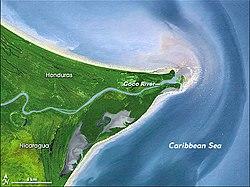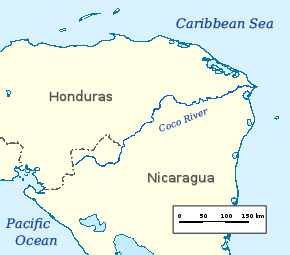| Coco River | |
|---|---|
 | |
| Location | |
| Countries | Nicaragua and Honduras |
| Physical characteristics | |
| Source | |
| • location | Somoto Canyon, Madriz Department, Nicaragua |
| • coordinates | 13°27′06″N 86°42′32″W / 13.45167°N 86.70889°W |
| • elevation | 2,219 ft (676 m) |
| Mouth | Caribbean Sea |
• location | Nicaragua |
• coordinates | 15°00′N 83°08′W / 15.000°N 83.133°W |
• elevation | 0 ft (0 m) |
| Length | 750 km (470 mi) |
The Río Coco, formerly known as the Río Segovia, Cape River,[1] or Yara River,[2] is a river in northern Nicaragua and southern Honduras. The Miskito Indians who live along the river know it as the Wanki or Wanks River. It is the longest river that runs entirely within the Central American isthmus.[3]
The river originates in the Somoto Canyon National Monument, near where the Pan American Highway crosses into Nicaragua, and flows through low mountainous terrain 750 kilometres (470 mi) into the Caribbean Sea at Cabo Gracias a Dios; the middle and lower reaches form the Honduras-Nicaragua border.
On September 7, 2007, major international news wires reported that the Río Coco was over 11 metres (36 ft) above normal stage, two days after category 5 Hurricane Felix made landfall.
Location
| Point | Coordinates (links to map & photo sources) | Notes |
|---|---|---|
| Somoto Canyon - source | 13°27′06″N 86°42′32″W / 13.4518°N 86.7088°W | Elevation: 2219 ft |
| El Ocotal | 13°36′40″N 86°28′10″W / 13.6111°N 86.46944°W | Elevation: 1776 ft |
| Los Encuentros | 13°29′45″N 86°16′00″W / 13.4959°N 86.2667°W | Elevation: 1509 ft |
| Jicaro River confluence | 13°31′00″N 86°00′10″W / 13.5167°N 86.0028°W | Elev: 1150 ft |
| Joins Nicaraguan-Honduran border | 13°49′58″N 85°45′10″W / 13.8328°N 85.75278°W | Elev: 856 ft |
| Waspam | 14°44′45″N 83°58′20″W / 14.7458°N 83.9722°W | Elev: 83 ft |
| Cabo Gracias a Dios - mouth | 15°00′00″N 83°08′00″W / 15.00°N 83.1334°W | Elev: 0 ft |
See also
- Honduras–Nicaragua border
References
- ^ Cape River-Capua, Chest of Books website, accessed 8 March 2010.
- ^ Wilson, J. G.; Fiske, J., eds. (1900). . Appletons' Cyclopædia of American Biography. New York: D. Appleton.
- ^ Aragón R., William. "Desentrañando el Gran Cañón". La Prensa (in Spanish). Archived from the original on 2007-08-07. Retrieved 2007-08-08.
